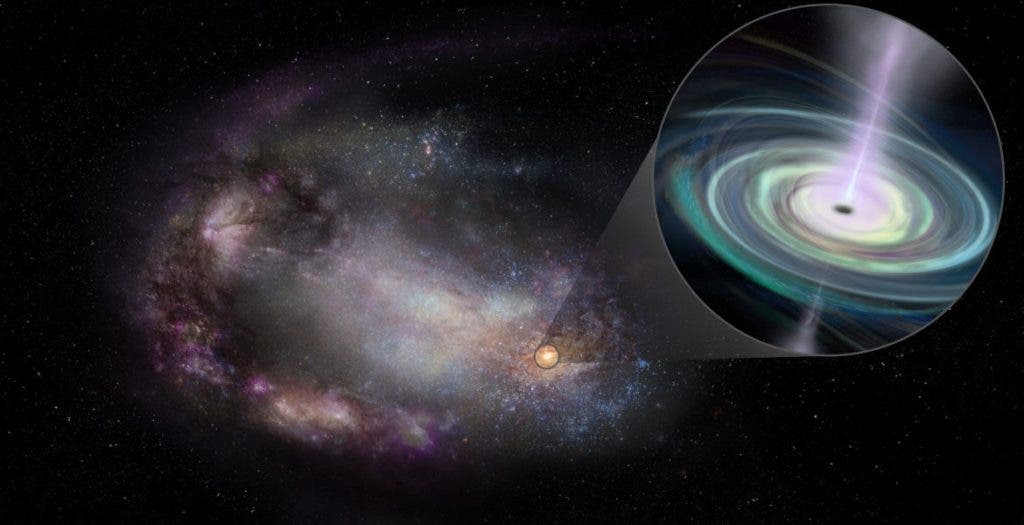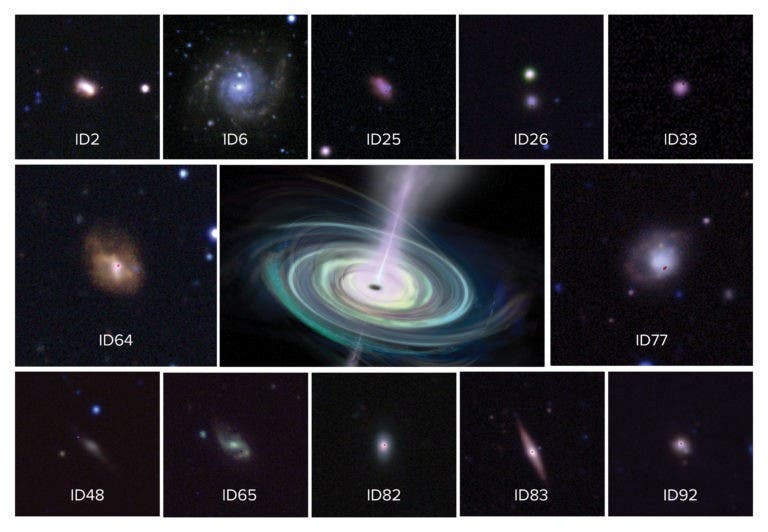
Dwarf galaxies have traditionally been considered too small to host massive black holes, but new research emerging from Montanna State University (MSU) has revealed dozens of examples. The research, published in the Astrophysical Journal has delivered another surprise, these black holes aren’t located where scientists usually expect to find them.
“All of the black holes I had found before were in the centres of galaxies,” says Amy Reines, an assistant professor in the Department of Physics in the College of Letters and Science. “These were roaming around the outskirts. I was blown away when I saw this.”
Reines and her team searched 111 dwarf galaxies within a radius of a billion-light-years of Earth using the National Science Foundation’s Karl G. Jansky Very Large Array at the National Radio Astronomy Observatory, Albuquerque, New Mexico. During the course of their search, they identified 13 galaxies that very probably host black holes, the majority of which were not centralised.
Reines is also a researcher in the MSU’s eXtreme Gravity Institute, which unites astronomers and physicists in order to study phenomena in which the gravitational influence is so powerful that it blurs the separation of space and time. This includes events and objects such as neutron stars, black holes, mergers and collisions between the two and even, the initial extreme period of rapid expansion of the universe — the big bang.
The researcher explains that whilst stellar-mass black holes — those with a mass of up to 10 times that of our Sun — form as large stars undergo gravitational collapse, we are, thus far, uncertain how supermassive black holes form. This class of black hole which can have masses of up to billions of times that of the Sun is most commonly found in the centre of galaxies.
This is certainly the case with our galaxy, the Milky Way, which hosts the supermassive black hole Sagittarius A* (SgrA*) at its centre. Dwarf galaxies are smaller than spiral galaxies like the Milky Way, containing a few billion stars rather than 100–400 billion as spiral galaxies tend to.
The results collected by Reines confirm computer simulations generated by Jillian Bellovary, assistant professor at Queensborough Community College, New York and Research Associate at the American Museum of Natural History.
How black holes get lost
Bellovary’s computer simulations suggested that black holes could be disturbed from the centre of dwarf galaxies by interactions they undergo as they travel through space. This result coupled with Reines’ study have the potential to change the way we look for black holes in dwarf galaxies going forward. This change in thinking could also impact theories of how both dwarf galaxies and supermassive black holes form.
“We need to expand searches to target the whole galaxy, not just the nuclei where we previously expected black holes to be,” Reines adds.
No stranger for the search for black holes, Reines has been hunting these events for a decade, ever since she was a graduate student at the University of Virginia. Whilst she initially focused on star formation in dwarf galaxies, her research led her to something else that captured her interest: a massive black hole “in a little dwarf galaxy where it wasn’t supposed to be.”

The little dwarf galaxy she refers to is Heinze 2–10, located 30-million-light-years from Earth, which had previously been believed too small to host a massive black hole. “Conventional wisdom told us that all massive galaxies with a spheroidal component have a massive black hole and little dwarf galaxies didn’t,” Reines explains, adding that when she discovered such a relationship it was a “eureka” moment. After publishing these findings in the journal Nature she continued searching for further black holes in dwarf galaxies. “Once I started looking for these things on purpose, I started finding a whole bunch,” Reines says.

Changing her tactics by shifting from visual data from radio signals, Reines uncovered over 100 possible black holes in her first search of a sample that included 40,000 dwarf galaxies. In current search, as described in the latest paper, Reines returned to radio searches, hunting for radio signatures with that sample. This, she says, should allow her to find massive black holes in star-forming dwarf galaxies, even though she has only found one thus far.
“When new discoveries break our current understanding of the way things work, we find even more questions than we had before,” comments Yves Idzerda, head of the Department of Physics at MSU.
As for Reines, the search continues.
“There are lots of opportunities to make new discoveries because studying black holes in dwarf galaxies is a new field,” she said. “People are definitely captivated by black holes. They’re mysterious and fascinating objects.”
Original research: https://iopscience.iop.org/article/10.3847/1538-4357/ab4999


